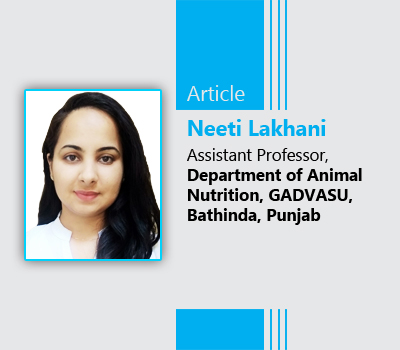Canola, belonging to the family of Brassicas, is produced as a byproduct of rapeseed during oil extraction process. Canola differs from rapeseed in its lower glucosinolate and low oil content. Production of canola meal is the second largest in the world after soybean meal (Aachary et al., 2015). Canola meal is used as a feed ingredient because of its consistent quality having higher essential amino acid and good quality protein. The increasing diet cost in animal production has made canola meal an efficient alternative to reduce feed cost.

Canola Meal as feed ingredient
Chemical composition of Canola Meal
The chemical composition of canola meal resembles closely with soyabean meal and can be used to complement the supplementation of soyabean meal in livestock diet. Canola meal is rich in levels of methionine, lysine, cysteine and tryptophan than those of the other commonly used cereal varieties. It has higher fat content for phospholipids, triglycerides and free fatty acids. With high protein content and an excellent amino acid profile, canola meal is evidenced to support high levels of production in livestock species. The high digestibility and palatability of meal makes it a perfect replacer of vegetable protein in ration. The high fiber content of canola meal restricts its quality and interferes with the digestibility of meal, however, it is the amino acid profile and presence of sulphur containing amino acids which enhance the quality of canola meal. The amounts of available Ca, Mg and P are higher in canola meal whereas K and Cu contents are lower. Vitamins specially biotin, niacin, choline, thiamin are present in higher amount with lower pantothenic acid levels.
| Chemical composition of canola meal (% moisture) | |
| Moisture | 12 |
| Crude protein | 36 |
| Ether extract | 3.3 |
| Linoleic Acid | 0.67 |
| Linolenic Acid | 0.32 |
| Crude Fiber | 11.2 |
| Sinapine | 1.0 |
| Phytic acid | 2.3 |
| Glucosinolates (µmol/g) | 4.2 |
Canola meal inclusion in poultry diet
Canola meal provides excellent value in diets where the greatest emphasis in formulation is placed on amino acid balance. Inclusion of canola meal at 20% level is made when diet formulation is well balanced specially for its amino acid content, having no influence on growth rate and feed efficiency (Rogiewicz et al., 2015). The lower energy content in canola meal restricts its inclusion in broiler ration not more than 10% of diet. However, incorporation of extra animal fat along with canola meal will help bring up the energy level and increase the inclusion level in broiler diet. Inclusion levels of canola meal in layer diet was earlier restricted to 10% because of liver hemorrhage mortality which was significantly observed in layers fed on higher inclusion levels of canola meal. However, the presence of sinapine in canola meal causes delay in breakdown of trimethylamine, imparting fishy flavor in the eggs.
| Inclusion level of canola meal :- | |
| Poultry | Inclusion level (%) |
| Starter | 20% Max. |
| Grower | 30% Max. |
| Egg layer | 20% Max. |
| Breeder | 30% Max. |



Factors affecting utilization of canola meal
Factors which affect the utilization of canola meal in diet include its glucosinolates, sinapine, phytic acid, tannins, dietary fiber, and electrolyte balance. These anti nutritional factors hinder animal growth performance by interfering with nutrient absorption in the digestive system.
Fiber- Canola meal fiber is rich in NSP, lignin associated with polyphenols and polyphenol glycoproteins. The content of these fibers is three times higher than soyabean meal.
Glucosinolates- The sulphur containing plant secondary metabolite itself is not harmful to the animal but the breakdown products of glucosinolates impair liver and kidney function, inhibit thyroid hormone production and cause depression in growth performance.
Phytic acid- Canola Meal contains 4-6 % of phytic acid, reducing its nutritional value by binding to multivalent cations (Zn, Ca, and Fe) reducing the nutrient digestibility in animals. Sinapine- Is bitter tasting phenolic compound contributing to unpleasant flavor in feed and limiting feed intake in animals.















